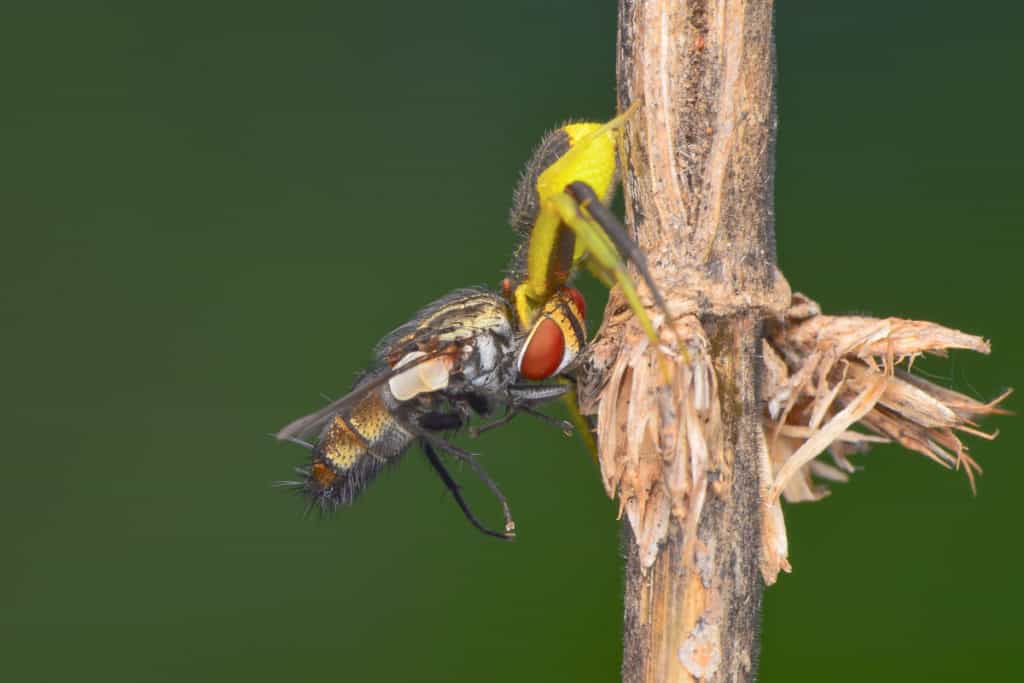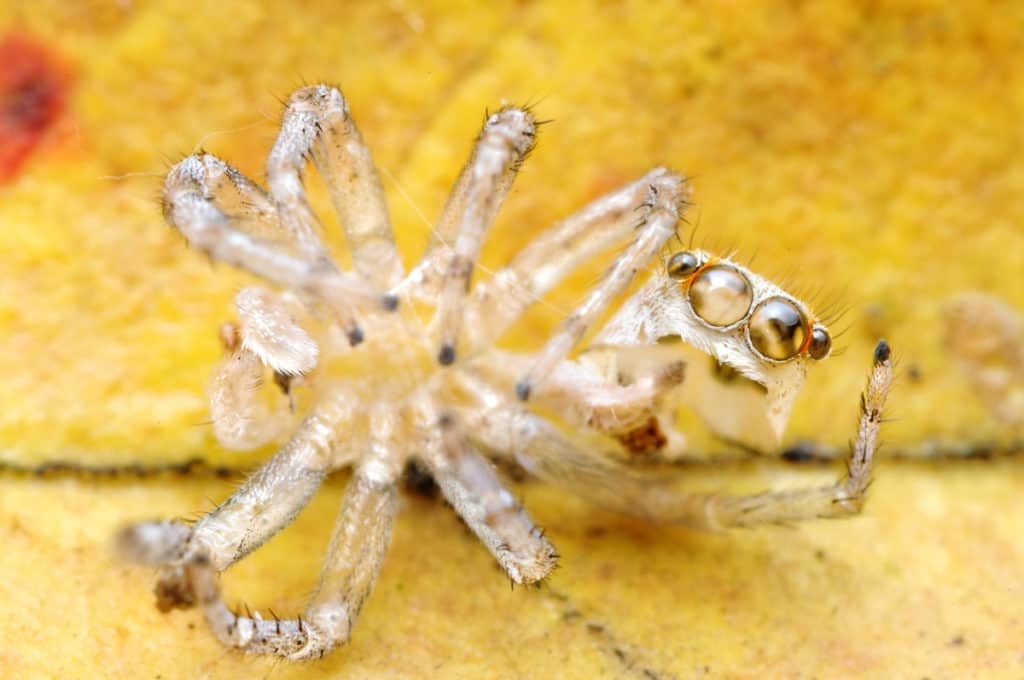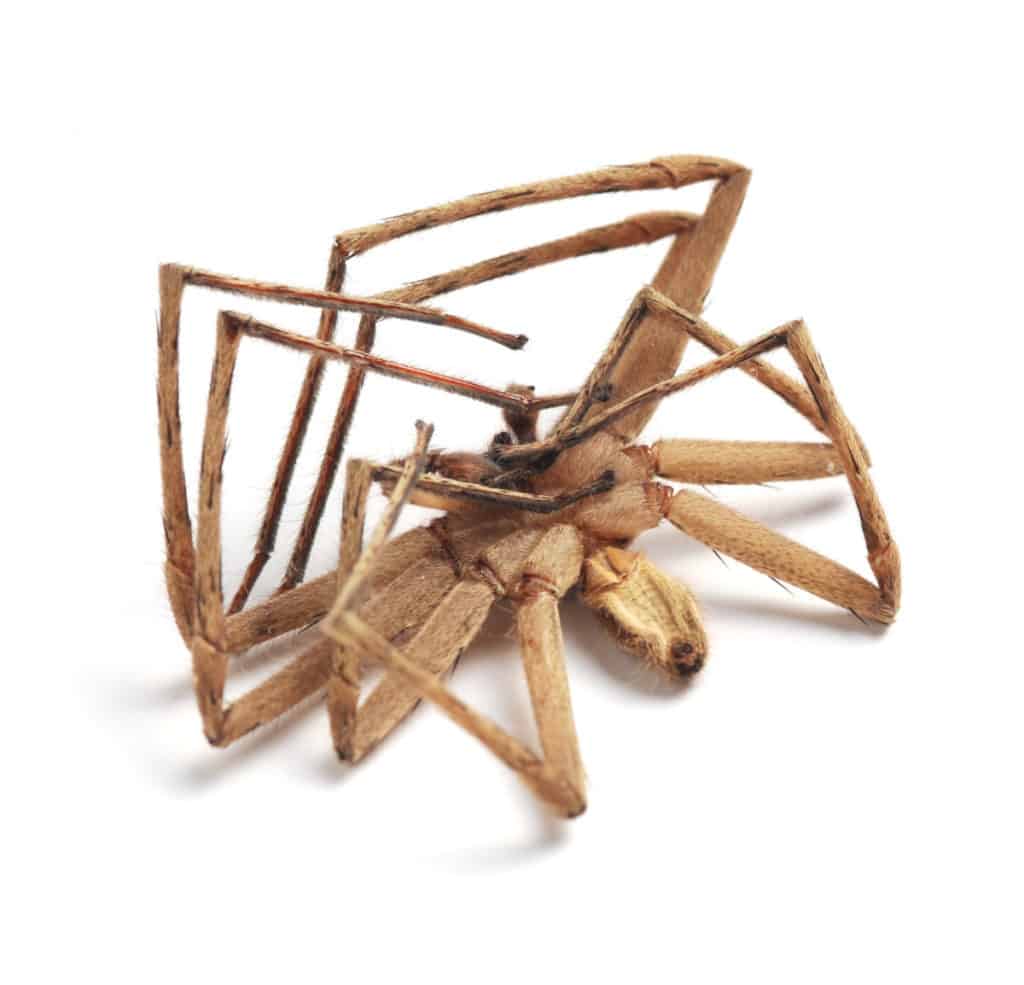The animal kingdom is vast, nature is extremely beautiful and varied when it comes to the different species of animals and insects that exist. Although insects generally get a bad rep on account of being ‘creepy-crawlies’, they are truly fascinating creatures and we can learn much from studying them.
To that end, we take a look at the wonderfully hair-raising spider, and more specifically whether they have bones or not and how they manage to navigate through their daily lives.
So, Do Spiders Have Bones? No, spiders don’t have bones. Spiders don’t have an internal skeleton, instead, they have an external support system called an exoskeleton. Their exoskeleton is made of chitin, hard fibrous material with membranes around joints for flexibility. The exoskeleton is like body armor for a spider.
The Exoskeleton
Humans and other mammals have an internal support structure in the form of bones, this is known as an endoskeleton and it allows us to move about and take part in various activities. Spiders on the other hand do not have an endoskeleton.
To define it simply, the exoskeleton is a hard “shell” of sorts that is composed of a substance known as chitin. Chitin covers the outer surface of the arthropod’s body to offer it support, structure, and of course, protection.
Unlike humans whose bones grow with time, an exoskeleton cannot grow with the spider. As such, the spider will shed their exoskeleton over time in a process known as molting and we discuss this further later in the article.
Exoskeleton Pros
● Exoskeletons, unlike internal skeletons, offer spiders an extra level of protection as they cover the entire body. Despite their appearance and reputation, spiders also require protection against potential threats and predators and the exoskeleton offers this.
● Due to the nature of exoskeletons, spiders tend to have more strength and power in comparison to other creatures of similar size with internal skeletons. This is because the exoskeleton offers more leverage in terms of movement, as well as their ability to pick up objects.

Exoskeleton Cons
● Unlike bones found in internal skeletons, exoskeletons can be broken relatively easily when enough pressure is applied – think back to the last time you whacked a spider out of fear or the last time you had to crack a crab shell for dinner.
● Exoskeletons will not grow along with the creature. This means that spiders must shed, or molt, their exoskeletons as they grow in size. This may inadvertently expose them to predators during this process.
Do Spiders Molt Their Exoskeleton?
As we had previously mentioned, exoskeletons do not grow along with the spider and as time goes on they will need to molt their exoskeleton as they begin to outgrow it. Molting occurs soon after the baby spiders have begun feeding and typically continues till adulthood, although some spiders may spend most of their lives molting.

When a spider is ready to begin molting, its body will begin generating a new cuticle layer which will, in turn, lead to the creation of another exoskeleton. The spider then administers a molting fluid in the space between the new and old exoskeleton, this creates a gap between the old and new exoskeleton which allows for easy separation of the two.
Once the two exoskeletons begin to separate the spider will increase its heart rate which in turn raises its blood pressure and allows it to force the older exoskeleton to crack when the spider flexes its muscles. The spider will then break out of its old exoskeleton.
How Often Do Spiders Molt?
Molting is a necessity in spiders and other arthropods, and it is something that simply must just happen, the same way a snake must shed its skin when the time comes.
How often a spider molts its exoskeleton is contingent on a number of factors:
- Age
- Species
- How much they eat
1. Age
Spiders tend to molt more frequently when they are younger since they are still growing in size and stature. As such, younger spiders may molt at least once a month, though some owners have seen younger spiders molt up to twice a month. As they get older, spiders may molt once every year or two.
How long do you think spiders live? We have written an article that covers this if you are interested. It’s called, How Long Do Spiders Live?
2. Species
The species of the arthropod in question will play a role in how often it molts. Some of these have ‘internal body clocks’ that necessitate them to molt after a certain number of days, weeks, etc. Other arthropods, such as the Nephila spider must first gain enough weight, and mass before they can begin the molting process.
Ever wondered what happens to a spider if it can’t eat? So did we, so we did the research and wrote an article about it. If you are interested the article is called, How Long Can Spiders Live Without Food?
3. How Much They Eat
A study conducted at the University of Vermont seemed to hypothesize that the volume of food spiders ate played a role in how often they molt. It was observed that the more a spider eats the more it gains weight thus resulting in the necessity to molt.
A rather interesting observation from this study was that the spiders that ate too much and grew too rapidly had higher rates of death during the molting process.
For the full story on what the diet of spiders is like check out this article we have written, What Do Spiders Eat?
So How Do Spiders Move Without Bones?
Spiders have a reputation for being ‘creepy’ partly due to the way they move. After all, they do have eight legs and if we’re being honest it can be a bit weird watching them move about, especially at the speed that they move.
In spiders, the segments of the exoskeleton are composed of joints that allow for inward movement of their legs by way of the spiders contracting the muscles which are connected to their exoskeleton. Because they lack the muscles to extend their legs outwards, spiders achieve this by using bodily fluids to push the legs outwards.
If you notice a spider lying with its legs curled this means it is unable to move due to a lack of the necessary bodily fluids needed to move its legs.
So if a spider can’t get food, it raised a couple of questions, Can spiders drink water, and if so how? Do spiders have tongues to lap up the water?
We have got the answers to the question in two other articles we have written, Do Spiders Drink Water? and, Do Spiders Have Tongues?

So even though spiders do not have bones, their physical anatomy is composed in such a way that they can still move without the need for bones. Furthermore, spiders move by moving two legs at a time as opposed to simultaneously running with all eight.
What’s The Difference Between A Skeleton And An Exoskeleton?
As briefly mentioned earlier spiders fall under the category of arthropods, which are animals that lack a backbone. Arthropods typically have exoskeletons and as we have discussed they are found outside of the animal’s body and unlike internal skeletons, they do not grow in size over time, hence the necessity to molt.
Unlike an exoskeleton that needs to be regularly molted with time to accommodate for the growth of the spider, internal skeletons do grow along with the animal in question and these generally tend to be found in vertebrates, otherwise known as animals with a backbone.
The Wrap Up
Given the information we’ve covered in this article, we can definitively come to the conclusion that spiders do not have bones and they do not make up for any part of the spider’s anatomy.
Sources
https://www.uvm.edu/~lehiggin/Growth_by_molting.html
https://citeseerx.ist.psu.edu/viewdoc/download?doi=10.1.1.482.7208&rep=rep1&type=pdf
https://animals.mom.com/5-characteristics-arthropod-5177.html
